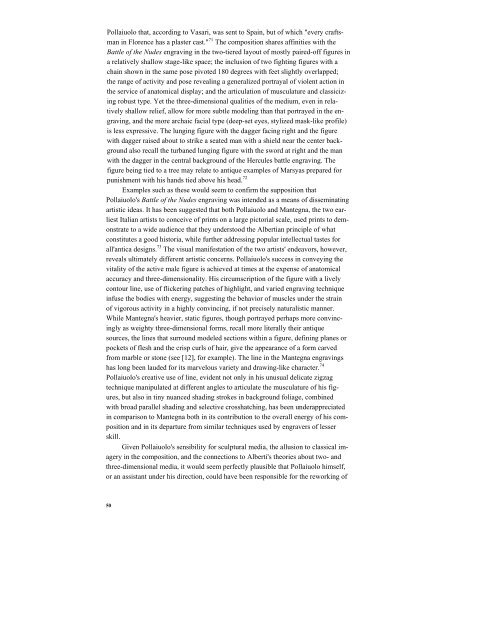Battle of the Nudes
Battle of the Nudes
Battle of the Nudes
Create successful ePaper yourself
Turn your PDF publications into a flip-book with our unique Google optimized e-Paper software.
Pollaiuolo that, according to Vasari, was sent to Spain, but <strong>of</strong> which "every crafts-<br />
man in Florence has a plaster cast." 71 The composition shares affinities with <strong>the</strong><br />
<strong>Battle</strong> <strong>of</strong> <strong>the</strong> <strong>Nudes</strong> engraving in <strong>the</strong> two-tiered layout <strong>of</strong> mostly paired-<strong>of</strong>f figures in<br />
a relatively shallow stage-like space; <strong>the</strong> inclusion <strong>of</strong> two fighting figures with a<br />
chain shown in <strong>the</strong> same pose pivoted 180 degrees with feet slightly overlapped;<br />
<strong>the</strong> range <strong>of</strong> activity and pose revealing a generalized portrayal <strong>of</strong> violent action in<br />
<strong>the</strong> service <strong>of</strong> anatomical display; and <strong>the</strong> articulation <strong>of</strong> musculature and classiciz-<br />
ing robust type. Yet <strong>the</strong> three-dimensional qualities <strong>of</strong> <strong>the</strong> medium, even in rela-<br />
tively shallow relief, allow for more subtle modeling than that portrayed in <strong>the</strong> en-<br />
graving, and <strong>the</strong> more archaic facial type (deep-set eyes, stylized mask-like pr<strong>of</strong>ile)<br />
is less expressive. The lunging figure with <strong>the</strong> dagger facing right and <strong>the</strong> figure<br />
with dagger raised about to strike a seated man with a shield near <strong>the</strong> center back-<br />
ground also recall <strong>the</strong> turbaned lunging figure with <strong>the</strong> sword at right and <strong>the</strong> man<br />
with <strong>the</strong> dagger in <strong>the</strong> central background <strong>of</strong> <strong>the</strong> Hercules battle engraving. The<br />
figure being tied to a tree may relate to antique examples <strong>of</strong> Marsyas prepared for<br />
punishment with his hands tied above his head. 72<br />
Examples such as <strong>the</strong>se would seem to confirm <strong>the</strong> supposition that<br />
Pollaiuolo's <strong>Battle</strong> <strong>of</strong> <strong>the</strong> <strong>Nudes</strong> engraving was intended as a means <strong>of</strong> disseminating<br />
artistic ideas. It has been suggested that both Pollaiuolo and Mantegna, <strong>the</strong> two ear-<br />
liest Italian artists to conceive <strong>of</strong> prints on a large pictorial scale, used prints to dem-<br />
onstrate to a wide audience that <strong>the</strong>y understood <strong>the</strong> Albertian principle <strong>of</strong> what<br />
constitutes a good historia, while fur<strong>the</strong>r addressing popular intellectual tastes for<br />
all'antica designs. 73 The visual manifestation <strong>of</strong> <strong>the</strong> two artists' endeavors, however,<br />
reveals ultimately different artistic concerns. Pollaiuolo's success in conveying <strong>the</strong><br />
vitality <strong>of</strong> <strong>the</strong> active male figure is achieved at times at <strong>the</strong> expense <strong>of</strong> anatomical<br />
accuracy and three-dimensionality. His circumscription <strong>of</strong> <strong>the</strong> figure with a lively<br />
contour line, use <strong>of</strong> flickering patches <strong>of</strong> highlight, and varied engraving technique<br />
infuse <strong>the</strong> bodies with energy, suggesting <strong>the</strong> behavior <strong>of</strong> muscles under <strong>the</strong> strain<br />
<strong>of</strong> vigorous activity in a highly convincing, if not precisely naturalistic manner.<br />
While Mantegna's heavier, static figures, though portrayed perhaps more convinc-<br />
ingly as weighty three-dimensional forms, recall more literally <strong>the</strong>ir antique<br />
sources, <strong>the</strong> lines that surround modeled sections within a figure, defining planes or<br />
pockets <strong>of</strong> flesh and <strong>the</strong> crisp curls <strong>of</strong> hair, give <strong>the</strong> appearance <strong>of</strong> a form carved<br />
from marble or stone (see [12], for example). The line in <strong>the</strong> Mantegna engravings<br />
has long been lauded for its marvelous variety and drawing-like character. 74<br />
Pollaiuolo's creative use <strong>of</strong> line, evident not only in his unusual delicate zigzag<br />
technique manipulated at different angles to articulate <strong>the</strong> musculature <strong>of</strong> his fig-<br />
ures, but also in tiny nuanced shading strokes in background foliage, combined<br />
with broad parallel shading and selective crosshatching, has been underappreciated<br />
in comparison to Mantegna both in its contribution to <strong>the</strong> overall energy <strong>of</strong> his com-<br />
position and in its departure from similar techniques used by engravers <strong>of</strong> lesser<br />
skill.<br />
Given Pollaiuolo's sensibility for sculptural media, <strong>the</strong> allusion to classical im-<br />
agery in <strong>the</strong> composition, and <strong>the</strong> connections to Alberti's <strong>the</strong>ories about two- and<br />
three-dimensional media, it would seem perfectly plausible that Pollaiuolo himself,<br />
or an assistant under his direction, could have been responsible for <strong>the</strong> reworking <strong>of</strong><br />
50
















